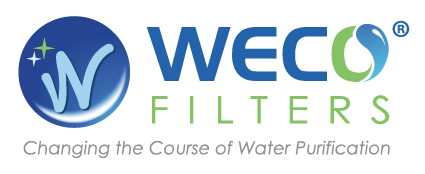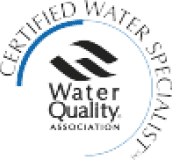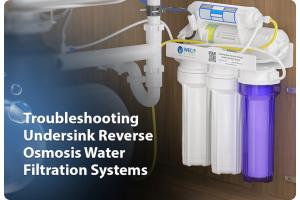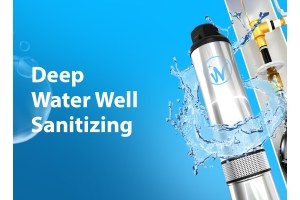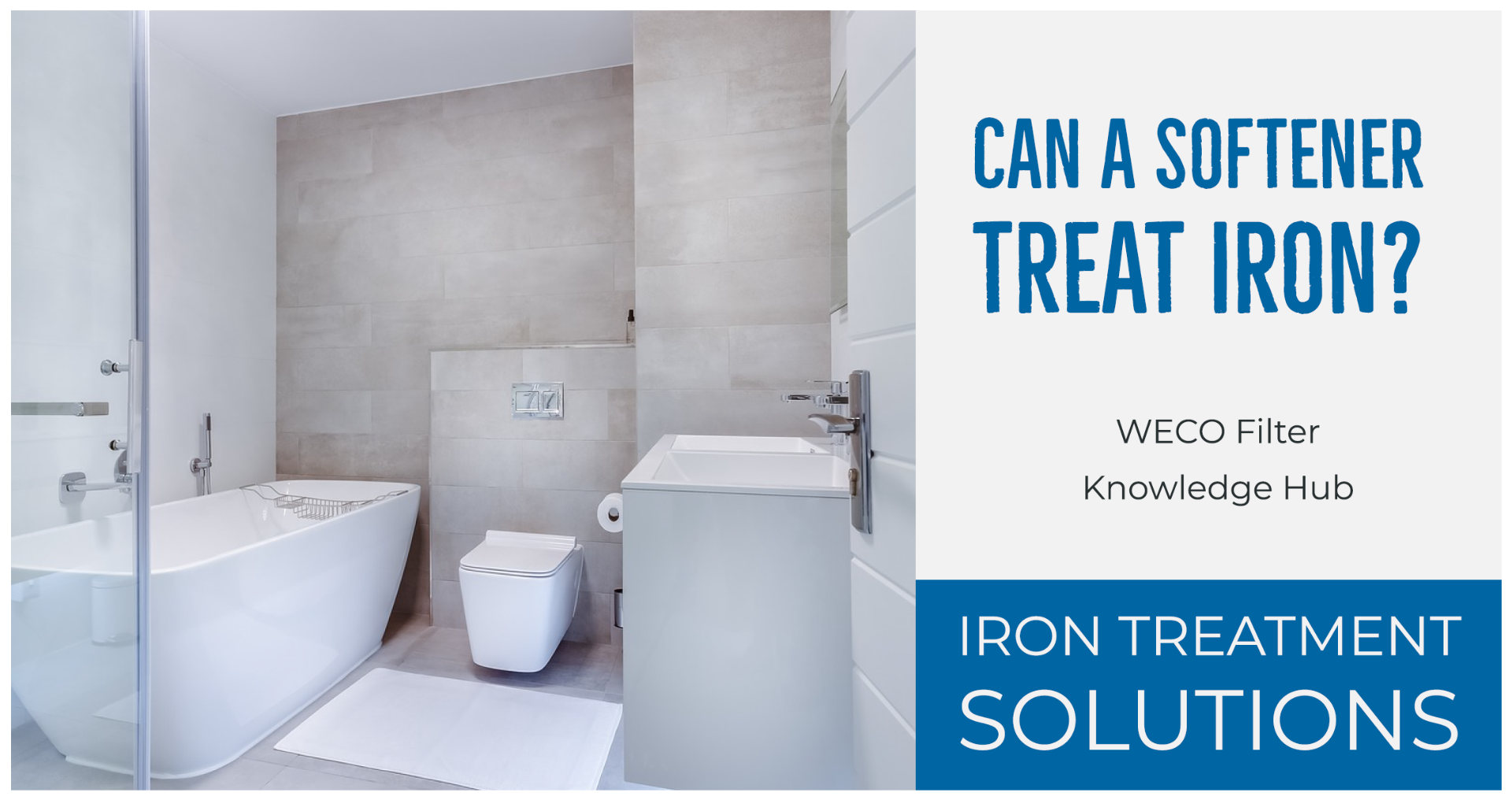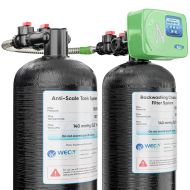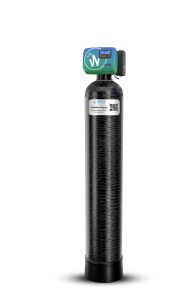Can a Water Softener Treat Iron?
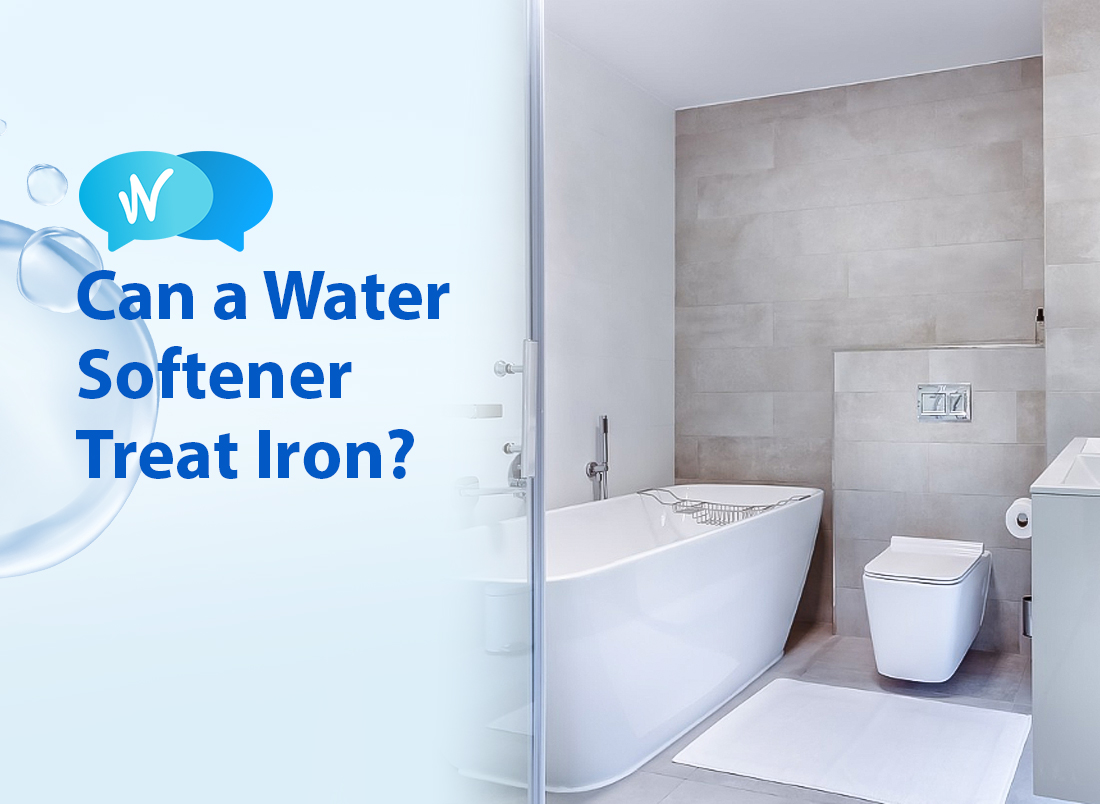
Our experts can help you determine the correct system, so please consult us before ordering. The limiting factors in choosing the proper filtration media include the amount of dissolved oxygen, pH level, oxidation-reduction potential (ORP), water temperature, and carbon dioxide (CO2). Let WECO help you find the proper system to best meet your needs.
How much iron is too much in my water?
Water sample analysis should always report the combination of all forms of iron present in the sample. A high concentration of all forms of iron lead to an unacceptable characteristic in water that makes it unsuitable for drinking, washing dishes, bathing, and laundry.
High levels of iron in your water – a total iron concentration of 0.3 PPM or higher -- can stain kitchen and bathroom fixtures, dishes, cookware, laundry, and masonry surfaces.
Domestic uses of water allow iron concentrations of 0.1 parts per million (ppm) or milligrams per liter (mg/L); however, several industrial applications call for a total absence of iron concentration in water that is used for process work.
So, can a water softener alone treat iron?
Theoretically, if the water has sufficient levels of calcium and magnesium ions, yes; however, iron reduction through softening is an old and largely inefficient technique that involves using and wasting salt that finds its way into groundwater. This is one reason why softeners are increasingly being banned from use.
According to guidelines from the Water Quality Association, a water softener can remove iron from water with a minimum pH of 6.7 (unaerated water) with an efficiency of 0.5 PPM of iron (Fe) for every grain per gallon (GPG) of hardness, up to 10 ppm. However, our WECO experts recommend that you do not use softeners for iron reduction. The salt generated from softening makes its way into groundwater supplies, which becomes difficult for municipalities to treat in the wastewater. By increasing efficiencies to reasonable levels and not using extremely wasteful designs, such as using a softener for iron reduction, we can reduce our reliance on water softeners and help wastewater treatment a more manageable process.
The principle of ion exchange can be used to treat water containing high levels of dissolved iron (water clear when drawn) without softeners. According to the ion exchange principle, calcium and magnesium ions can be exchanged for dissolved iron.
A co-current regenerating cation exchange water softener can be utilized to treat dissolved iron concentrations of 1 ppm or lower. Treatment of dissolved iron concentrations of above 1 ppm should involve oxidizing technologies to maintain softener efficiency.
To successfully remove dissolved iron utilizing ion exchange methods, use the following cardinal rules:
1. Eliminate any contact with air.
2. Regenerate the ion exchange softener vigorously and often before the actual softening capacity of the softener is exhausted.
The following reaction governs the removal of iron and/or manganese during softener regeneration [from E. Nordell, Water Treatment for Industry]:
R2Fe + 2NaCI -----> 2RNa + FeCl2
and
R2Mn + 2NaCI -----> 2RNa + MnCl2
R = Cation Exchange Resin
What is Iron Bacteria?
Like many elements, iron can exist in a few chemical forms. Fe(II) and Fe(III) are two common states for iron: Fe(II), or water-soluble ferrous iron, and Fe(III), or ferric iron, which is insoluble in sea water. As their name implies, iron bacteria are microorganisms that have developed specialized machinery to thrive off of ferric iron. Iron bacteria are microorganisms that use the oxidation of ferrous iron to ferric iron to “fix” dissolved carbon dioxide into organic molecules that they use to stay alive. Iron bacteria can thrive even at very low concentrations of dissolved iron. Iron bacteria, which belong to genuses such as Crenothrix, Leptothrix, and Gallionella, only need a continuous supply of Fe(III) and oxygen to metabolize ferric iron into their cell structures, and to deposit gelatinous ferric hydroxide iron compounds.
Iron bacteria growth results in the formation of a gelatinous sludge that can cause pipe encrustation and produce foul-tasting drinking water. Telltale signs of iron bacteria include the presence of a jelly-like mass and a surface that reflects an iridescent (rainbow) slick. Iron bacteria is one of the most difficult forms of iron to remove and control.
What is Colloidal Iron?
Colloidal iron can be visually detected in a water sample, as can ferric iron and organic ally-bound iron. However, unlike the others, colloidal iron stays in suspension, lending a red-pink, turbid hue to the water sample. Colloidal iron is very highly dispersed and has a very low specific gravity almost equal to that of water. The suspended particles of iron appear to be floating, and sometimes are bound to silica. The colloidal particles can have a slight negative charge. It may take a water sample containing colloidal iron 48 hours for the iron to begin accumulating at the bottom of the container. In municipal or industrial water treatment plants, colloidal iron is treated with the addition of aluminum sulfate (alum) or another coagulant. The iron binds to the coagulant and partially precipitates out; it can be removed from the water through a granular medium filter system.
How can excess iron be removed from my water?

Many years ago, Birm was a go-to media for iron removal. Katalox Light (KL) are other media used for iron removal. Every media has its pros and cons. KL media has a slightly higher backwash rate requirement than Birm, and tends to elevate the pH significantly on occasion. But, KL can handle far higher iron, manganese and H2S levels than Birm. Birm is highly restrictive in its application and oxidant use.
Please note that, like every other manganese dioxide ore based media, both KL and Birm have very definite limitations. Dissolved oxygen, pH, ORP, water temperature, carbon dioxide, and other factors all have to be taken into consideration in the iron removal process. Even then, it can be hit or miss.
KDF-85 filtration media is rated to treat iron and H2S (concentrations up to 5 ppm), but it is not a good choice, especially for treating higher levels of iron. KDF is rated for a higher effective flow rate than KL. However, KDF-85 is also considerably more expensive and the backwash rates simply make it a poor choice for residential iron reduction.
A final method for iron removal is air injection. The air injection method is a simple and reliable method of removing iron. Air is simply drawn in to the water every time the pump cycles. This air enters a tank which keeps a large air pocket that the water cascades through to further oxygenate the water. Excess air is purged out of the top of the tank. If air alone is not sufficient, a simple hydrogen peroxide injection system can be added later, if needed. However, most of the time, air is adequate.
References:
1. “Iron Water.” Water Quality Association, Knowledge Base Administration, www.wqa.org.
2. “Water Softener Forum, Questions and Answers.” Terry Love Plumbing & Remodel DIY & Professional Forum, terrylove.com.
